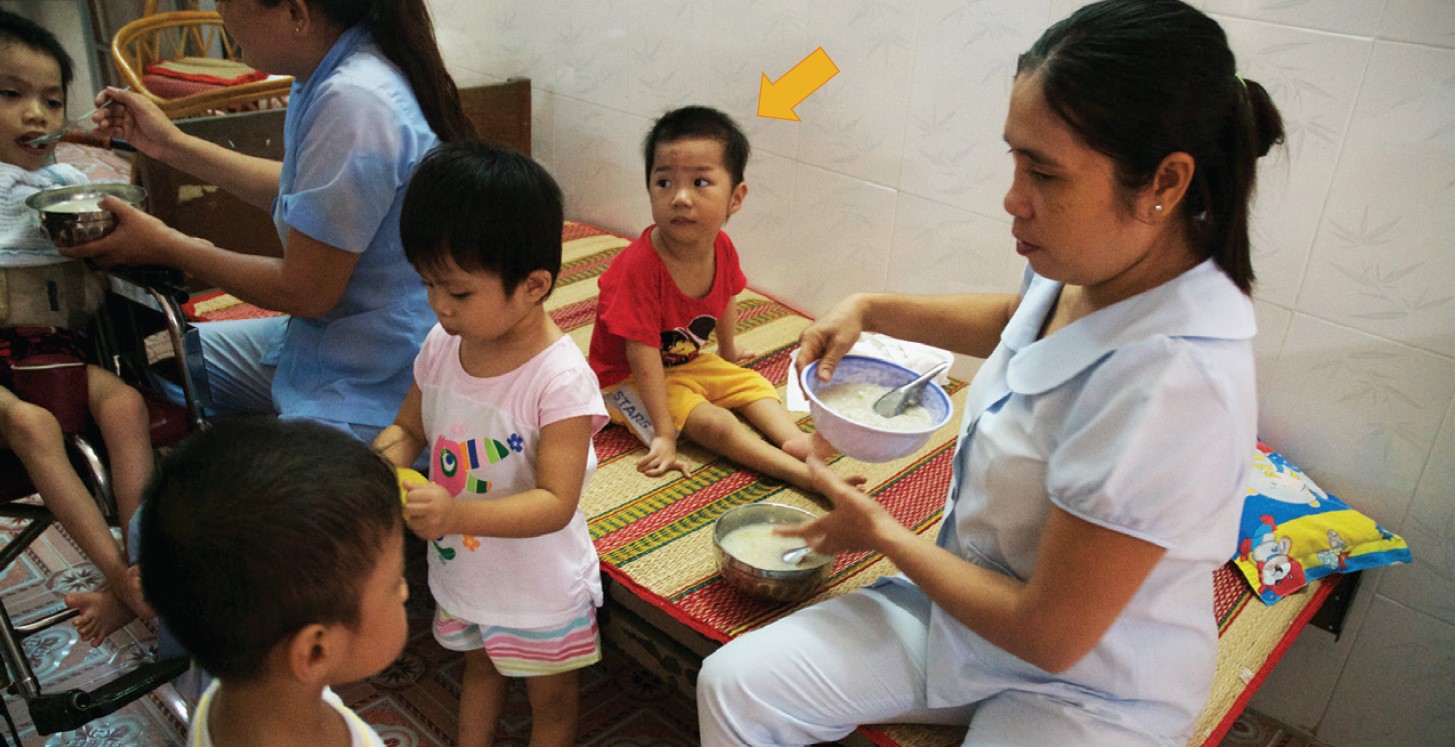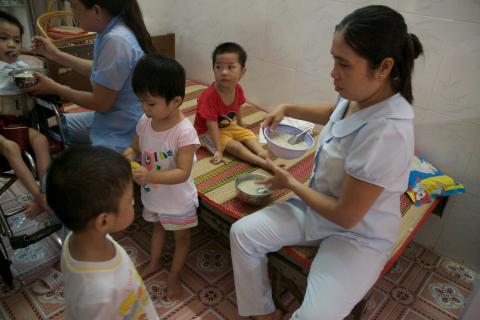Appropriate nutrition support for children in institution-based care: Is it too much to ask?
Emily DeLacey Director of Nutrition and Health Services at Holt International
The images shown in this article feature vulnerable children in institution-based care. Full consent was obtained and care was taken to feature appropriate imagery which is relevant and important to this story.
What we know: Children living in institution-based care (IBC) represent a forgotten population for the nutrition sector. This group remains particularly vulnerable to malnutrition, but many data and service gaps exist, especially for those with disabilities who make up a quarter of children in IBC.
What this adds: While global efforts focus on policies to discourage institutionalisation, more needs to be done to realise the rights of children living in IBC to appropriate nutrition and the engaged quality care needed to support growth and development. Good nutrition, growth, and development are, in turn, critical to home finding. This article highlights the positive impacts that can be achieved through caregiver training, appropriate feeding interventions, comprehensive monitoring and evaluation systems, and coherent government engagement.
Globally, between 3.18 million and 9.42 million children are estimated to be living in IBC (Desmond et al. 2020). Prior to their admission into IBC, many orphaned and vulnerable children may have faced compounding adversities. Prenatal substance exposure, trauma, neglect, abuse, and conditions such as HIV/AIDS or disabilities are commonly observed, making these children more vulnerable to developing malnutrition (Dozier et al. 2012). Those who are at higher risk – such as infants and children with disabilities – are overrepresented in IBC. More than one in three children in IBC are estimated to be aged under one year and one in four are estimated to have a disability (DeLacey et al, 2020). However, despite there being a large population of vulnerable children in IBC, this group is still regularly excluded from global nutrition conversations, research, and programming, as well as from routine essential health and nutrition services, surveys, and policy decisions. Much about their needs remains unknown.
In 2021, we conducted research to fill the information gap on the nutrition-related epidemiology of children living in IBC across six low- and middle-income countries: Mongolia, India, Ethiopia, Vietnam, China, and the Philippines (DeLacey et al. 2021). We used health records collected from Holt International’s nutrition screening database between 2013 and 2020. Data analysis of baseline nutrition screening from 2,926 children aged 0–18 years old revealed that children living within IBC were experiencing underweight (34.1%), stunting (37.3%), and wasting (12.6%). Overweight/obesity (12%), small head circumference (31%), and anaemia (28.7%) were also present. These levels of malnutrition were higher than any global or low- and middle-income country averages.
As mentioned, a quarter of children in IBC have a disability. Children with disabilities often experience feeding difficulties, such as choking and aspiration (inhalation of fluid or food into the lungs) during mealtimes – which can increase the risk of infections, respiratory complications, morbidity, and mortality. The presence of a feeding difficulty can also directly lead to malnutrition. Children might resist eating due to associated negative experiences or caregivers may provide nutritionally inadequate foods that they hope are easier for the child to safely swallow. Compounding this, feeding difficulties and accompanying malnutrition can both cause disability and exacerbate existing disabilities. In another study using the same programme data, we found that 11.3% of children in IBC had feeding difficulties. Among children with disabilities, 29.7% had feeding difficulties compared to 5.9% of children without disabilities. After adjusting for confounders, we found that children with disabilities had five times greater relative risk of having feeding difficulties than those without a disability (RR 5.08, 95% CI 2.65–9.7, p ≤ 0.001) (DeLacey et al. 2022a).
Collectively, these adversities greatly increase the risk of children not reaching their full potential. As a child spends more time in IBC, there are increasing consequences for their physical, cognitive, and interpersonal development.
Institution-based care: Our current reality
While not an ideal option, many orphaned and vulnerable children live in institutions that are necessary for their immediate care or protection. Living conditions are often insufficient to address the individual needs of children. This is especially true for infants and children with disabilities who rely on caregivers to meet basic needs and who may be unable to convey their requirements. Facilities are frequently limited in terms of staffing, funding, training, and resources. As such, caregivers have many competing priorities for their time, limiting responsive caregiving.
Children living in IBC have the same rights as other children in terms of appropriate nutrition, safe and enjoyable mealtimes, and the engaged quality care needed to support growth and development. These lifelong rights have been clearly outlined by several UN conventions and resolutions.
To date, global efforts have focused on policies to discourage institutionalisation – through guidance from the European Union, UNICEF, the World Health Organization, and others. There has been little to no focus on addressing the immediate needs and rights of children in IBC or actions to improve their current circumstances (Hope and Homes for Children, 2020). Funding remains insufficient for community initiatives to strengthen families, support caregivers, expand family-based care and respite care (short-term relief for primary caregivers), reunify families, and provide accessible health and nutrition services. Some governments have set up IBC reforms within their social welfare systems and developed family-based care alternatives, such as foster care. But those too remain unacceptably under-resourced, especially when children require highly specialised care or are malnourished.
Deinstitutionalisation is imperative to improving children’s developmental outcomes. However, it does not guarantee that all children experience optimal nutrition and health. Indeed, there is evidence that children and families in the same communities may be worse off than children living in IBC (Whetten et al. 2014). In these cases, IBC may offer more consistent access to nutritious meals and to the trained caregivers, peer support, and resources to provide impactful education, healthcare, and specialised therapies. The transition away from IBC is therefore nuanced and requires utmost care. Understanding the needs of families within communities, and learning why abandonment happened, is clearly an important step toward deinstitutionalisation. Otherwise, the process risks being detrimental if children are subsequently returned or placed in unsafe environments that are unable to meet their needs (Desmond et al. 2020).
Finally, the opportunity for family placement remains limited, especially when children are malnourished, sick, or unable to do activities of daily living. Disability-inclusive programming – from organisations such as Holt International, the Ubuntu-hub, and MAITS – provide training for caregivers that can improve child health and development and provide support to caregivers in communities, IBC, and foster care. When children are well nourished, it speeds up the process and increases the chance of placement in family-based care, family reunification, or adoption. This then decreases the time children spend in care and avoids the time and cost of nutrition treatment once they are placed with families.
As we work to strengthen families and support deinstitutionalisation efforts, we also need to address the current needs of the large and highly vulnerable population who remain in IBC.
Addressing child nutrition in institution-based care
Through its child nutrition programme, Holt International aims to both address the nutrition needs of children while they are in IBC and ease subsequent life options outside IBC. The programme includes comprehensive assessment, training, and monitoring and evaluation, and works in strong partnership with government structures to support both implementation and scaling.
We provide training for caregivers and nutrition and feeding interventions for children in institutions, foster care, and community programmes in nine countries, over 130 sites. More than 15,000 children have participated in the programme, with more than 7,000 caregivers trained. We use a training of trainer’s approach to improve individual- and site-level care practices. We provide caregivers and site staff with training on the following topics: providing safe and engaging mealtimes for children of different ages, feeding and positioning, hygiene and sanitation, growth monitoring, treating common illnesses, anaemia screening and treatment, micronutrient deficiencies, and other development topics. Within this, there is a special focus on the needs of infants and children with disabilities (DeLacey et al. 2022b).
In addition to robust monitoring and evaluation systems, the programme uses an electronic nutrition screening system that tracks growth measurements according to World Health Organization growth charts, incidence of illness, iron status and supplementation, and feeding interventions for each child. The system automatically calculates malnutrition risk and supports caregivers to examine children’s nutrition and growth over time and instigate changes to care if, for example, a child’s growth chart trends flat or downwards.
Analysis of programme data has showed the positive effects the child nutrition programme has had on feeding difficulties. Among children with feeding difficulties at baseline, 33.1% of 163 children with disabilities and 53.8% of 106 children without disabilities no longer had feeding difficulties after one year of participation in the programme (DeLacey et al. 2022a). This is likely related to improved caregiver practices, better positioning, and support from caregivers to develop skills like self-feeding. This analysis helped us to improve programme implementation by identifying sites with persistent nutrition issues or additional need for support. Sharing these findings with global audiences has helped raise awareness about the needs of children in IBC.
Quinn’s story: From institution-based care to a permanent family
In 2012, Quinn was abandoned as a newborn at a government-run institution in Vietnam by her birth family. It is unknown whether she was born premature or low birth weight. Quinn has arthrogryposis multiplex congenita, a condition present from birth that affects muscle development and often limits mobility and the ability to self-feed (figure 1).
Figure 1: Quinn, moving with the aid of a walking frame to support a congenital disorder in IBC
Quinn moving with the aid of a walking frame to support a congenital disorder in institution-based care in Vietnam, 2016. © Holt International |
Her health records indicate that, at 34 months of age, she was having difficulties chewing and was fed infant formula from a bottle or spoon-fed rice cereal. Her records also indicate that she was frequently hospitalised and experienced fevers and nausea/vomiting. She was stunted (according to height-for-age), underweight (according to weight-for-age), and anaemic. She was identified as malnourished and her caregivers received additional training from the nutrition programme staff on ways to improve her diet and to help her safely develop her chewing and feeding skills (figure 2). She was also provided with vitamins and iron supplementation.
Figure 2: Children being fed at a government-run institution in Vietnam
 Quinn and other children being fed during a mealtime at a government-run institution in Vietnam, 2016. © Holt International |
Quinn is highlighted by the yellow arrow in the image
In 2017, after four years and nine months of living in IBC, Quinn’s nutrition and health status had improved and she had learned to safely feed herself. She became healthy enough to be adopted by a family. Her adoptive family received extensive training by Holt during the adoption process on strategies required to meet the complex needs of a child with a disability, as well as skills to build trust and a strong relationship with a child who has experienced adversities. With support from her family and occupational and physical therapy, Quinn no longer has feeding or nutrition issues and is growing and developing well (figure 3).
Figure 3: Quinn growing and developing well, post-adoption
 Quinn growing and developing well, post-adoption at her home in the US. © Quinn's family. USA, 2021 |
Avenues to improve nutrition support in institution-based care
While we work to unite children with families, children in IBC still need to receive appropriate care and nutrition. With this in mind, we highlight some strategies that can improve nutrition support in IBC.
Caregivers need more training. They usually have limited education on caring for children, especially those with disabilities. Appropriate training content and support would allow caregivers to provide responsive caregiving, safe and enjoyable feeding, and support for children with disabilities. There is increasing evidence that sensory stimulation, including touching or playing with food, plays an important role in child development and recovery from malnutrition (Kamble et al. 2022). Exploring the importance of engaging, enjoyable mealtimes is just one example of how appropriate caregiver training can improve nutrition outcomes. Another, more obvious focus is on malnutrition screening and prevention. Specifically, ensuring that caregivers are aware of sufficient, age-appropriate dietary intake and can identify and treat malnutrition early and effectively. This requires high-quality training and ongoing support.
Interventions to address malnutrition faced by children in IBC, especially infants and children with disabilities, must be part of the overall care plan and standard practice of every institution. Nutrition and feeding interventions need to be integrated into an organisation’s workflow. Institutions can then work to support staff with frequent training, provide environments to enable best practices (e.g. easily accessible handwashing stations), and clear guidance on expectations.
IBC sites should create systems of accountability to ensure consistent and routine assessment of the nutrition and health of individual children and across a given site. Stronger routine monitoring and evaluation systems would not only enable governments to have a better picture of the number and conditions of children in IBC – thus raising visibility – but also improve the implementation of programmes supporting children in IBC. Such systems also help institutions to provide transparent and objective data, increasing accountability to governments.
Additionally, governments and organisations need to ensure nutrition and health standards are key aspects of any family-based care programmes, such as foster care or kinship care. Child protection, deinstitutionalisation, and family strengthening plans should also include core components of nutrition, hygiene and sanitation, safe feeding, and support for caregivers. As children become well nourished and cared for, family-based care (foster care, kinship care) should be the next stage whenever possible, as a part of permanency planning (family reunification, adoption).
Responsibility for IBC, child nutrition and development, healthcare services, disability services, foster care, and child protection are often spread across several government ministries. Governments will need to develop a clear vision and collaborate across all departments and levels to ensure meaningful actions create environments that best support children’s development. Increased funding to train caregivers and support family-based care is essential. With funding and resources aligned to policy and global reforms in child welfare practices, deinstitutionalisation can become actionable and prevent the detrimental consequences to children’s development seen in IBC.
Conclusion
Although not ideal, millions of children live in IBC today, and their needs cannot be ignored. We need to work to ensure all children live in conditions that will support their full and adequate development. As the global community works toward strengthening families and deinstitutionalising children, the children currently in IBC need to be included in the conversation, especially infants and those with disabilities. Nutrition status and development are critical elements in finding appropriate homes for these children. We therefore need to improve practices in IBC in the immediate term.
Governments need to better monitor children in IBC in their respective countries, including the large number with disabilities or malnutrition. This is crucial so that we can better understand and respond to the needs of this unique population. Evidence-based research offers a strong platform to raise awareness about this highly vulnerable population and to advocate for their needs and rights to be met. By the same token, sharing successful case studies and the learnings from interventions also remain powerful tools for change.
More can be done to ensure that children reach their full potential, regardless of where they reside early in their lives.
For more information, please contact Emily DeLacey at emilyd@holtinternational.org.
References
DeLacey E, Tann C, Groce N et al (2020) The nutritional status of children living within institutionalized care: A systematic review. PeerJ, 8, e8484
DeLacey E, Hilberg E, Allen E et al (2021) Nutritional status of children living within institution-based care: A retrospective analysis with funnel plots and control charts for programme monitoring. BMJ Open, 11, 12, e050371
DeLacey E, Allen E, Tann C et al (2022a) Feeding practices of children within institution-based care: A retrospective analysis of surveillance data. Maternal & Child Nutrition, 18, 3, e13352
DeLacey E, Tann C, Smythe T et al (2022b) Learning from the implementation of the child nutrition program: A mixed methods evaluation of process. Children, 9, 12
Desmond C, Watt K, Saha A et al. (2020) Prevalence and number of children living in institutional care: Global, regional, and country estimates. The Lancet Child & Adolescent Health, 4, 5, 370–377
Dozier M, Zeanah C, Wallin A et al. (2012) Institutional care for young children: Review of literature and policy implications. Social Issues and Policy Review, 6, 1, 1–25
Hope and Homes for Children (2020) Beyond institutional care: A roadmap for child protection and care system reform for governments in Latin America and the Caribbean. hopeandhomes.org
Ivey R, Kerac M, Quiring M et al. (2021) The nutritional status of individuals adopted internationally as children: A systematic review. Nutrients, 13, 1, 245
Kamble N, Mathur R, Gavali V et al (2022) Sensory stimulation and play therapy: Benefits in the treatment of severe wasting in India? Field Exchange 68. https://www.ennonline.net/fex/68/sensorystimulationandplaytherapycombatseverewastinginindia
Whetten, K, Ostermann, J, Pence, BW et al. (2014) Three-year change in the wellbeing of orphaned and separated children in institutional and family-based care settings in five low-and-middle-income countries. PLOS ONE , 9, 8, e104872
About This Article
Download & Citation
Reference this page
Emily DeLacey (2024). Appropriate nutrition support for children in institution-based care: Is it too much to ask? Field Exchange issue 73. https://doi.org/10.71744/hdq6-jr85


